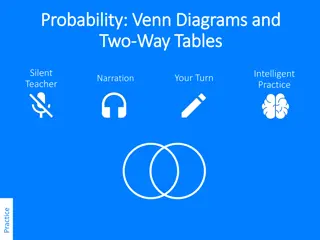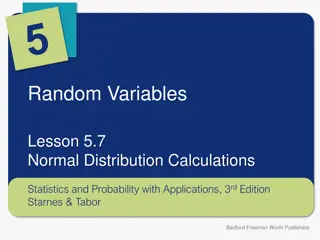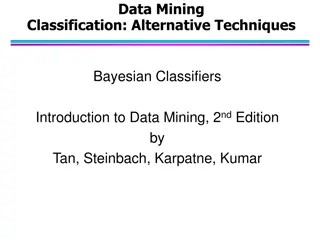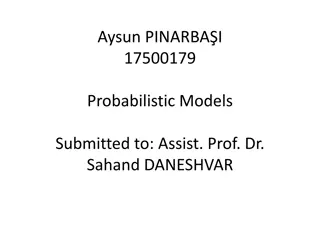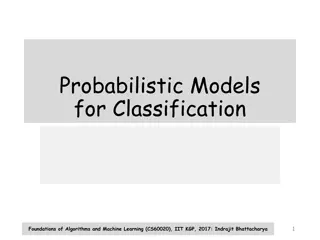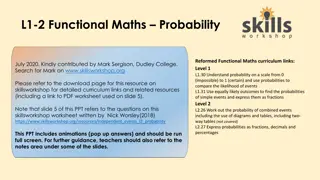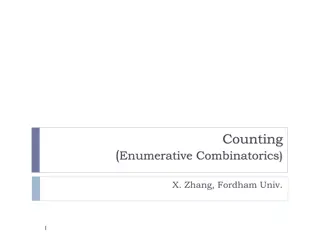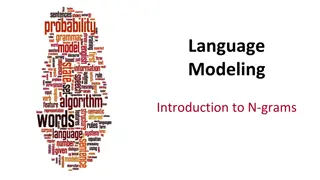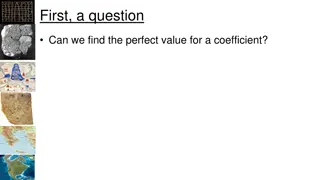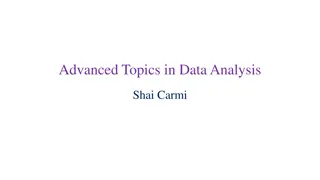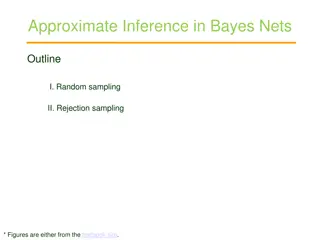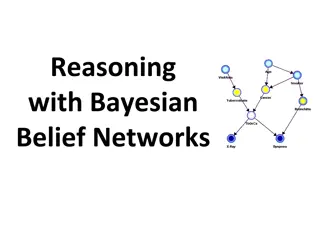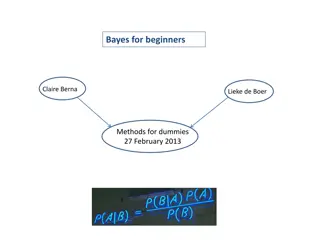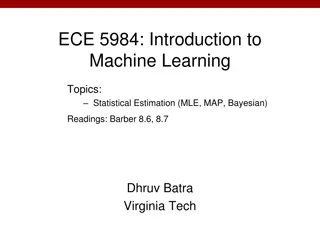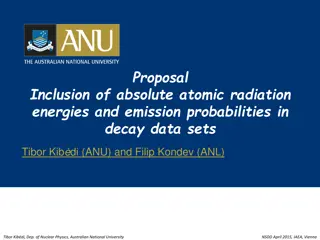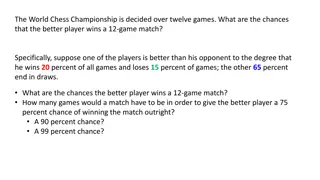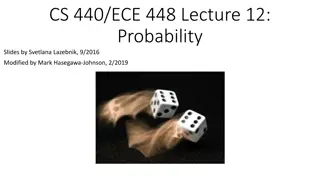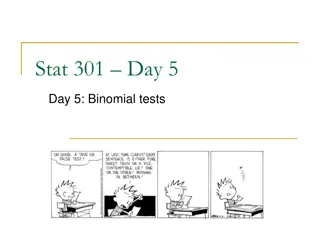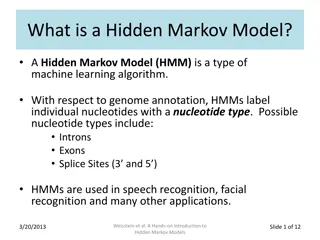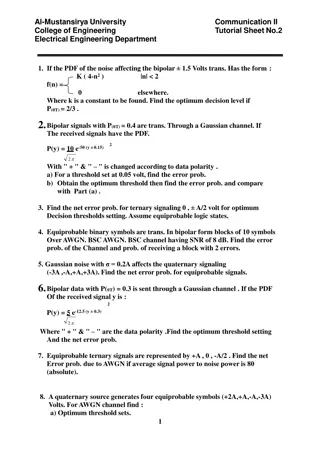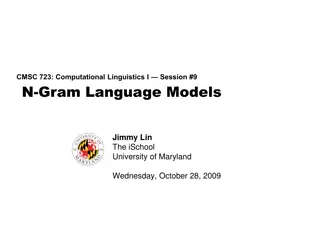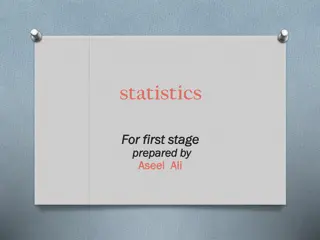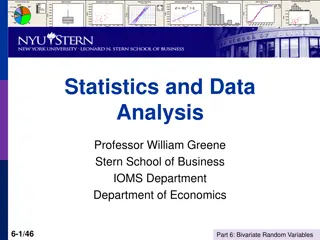Multivariate Analysis
Explore the key concepts of marginal, conditional, and joint probability in multivariate analysis, as well as the notion of independence and Bayes' Theorem. Learn how these probabilities relate to each other and the importance of handling differences in joint and marginal probabilities.
6 views • 43 slides
Probability and Two-Way Tables Practice Examples
Explore various probability scenarios through Venn diagrams and two-way tables in this practice session. Calculate probabilities of students liking specific sports and subjects, and determine conditional probabilities based on given conditions. Enhance your understanding of probability concepts with
0 views • 7 slides
Normal Distribution Calculations in Statistics
Exploring normal distribution calculations in Statistics involves calculating probabilities within intervals and finding values corresponding to given probabilities. This lesson delves into the application of normal distribution to determine probabilities of scoring below a certain level on tests an
3 views • 13 slides
Probabilities of Success in Clinical Trials
Exploring the concept of probabilities of success in clinical trials, this webinar discusses the assessment of new treatments, development plans, and success criteria. It covers factors like power, probability of success, and assurance in decision-making processes, emphasizing the consideration of a
1 views • 21 slides
Introduction to Bayesian Classifiers in Data Mining
Bayesian classifiers are a key technique in data mining for solving classification problems using probabilistic frameworks. This involves understanding conditional probability, Bayes' theorem, and applying these concepts to make predictions based on given data. The process involves estimating poster
0 views • 20 slides
Probabilistic Models: Examples and Solutions
This content delves into probabilistic models, focusing on computing probabilities by conditioning, independent random variables, and Poisson distributions. Examples and solutions are provided to enhance understanding and application. It covers scenarios such as accidents in an insurance company, ge
1 views • 12 slides
Foundations of Probabilistic Models for Classification in Machine Learning
This content delves into the principles and applications of probabilistic models for binary classification problems, focusing on algorithms and machine learning concepts. It covers topics such as generative models, conditional probabilities, Gaussian distributions, and logistic functions in the cont
0 views • 32 slides
Probability in Functional Maths Curriculum
Explore probability concepts in functional maths, such as understanding probability scales, comparing likelihood of events, calculating probabilities of simple and combined events, and expressing probabilities as fractions, decimals, and percentages. Practice drawing probability lines, simplifying f
1 views • 8 slides
Group Decision-Making: The Wisdom of Crowds and Stupidity of Herds
This presentation by Richard Zeckhauser of Harvard University delves into the importance of rational analysis and subjective probability in group decision-making processes. It emphasizes the need to focus on collective wisdom while avoiding biases that can affect group decisions. Key concepts covere
2 views • 22 slides
Analysis of Game Players and Disk Bag Contents
Survey data on gamers' nationality and gaming platform preferences, as well as the composition of a bag of disks, are analyzed to determine probabilities of events like selecting specific disks or gamers based on nationality and platform. The analysis involves calculations of probabilities for vario
0 views • 13 slides
Counting Strategies and Examples in Enumerative Combinatorics
Understanding counting principles in enumerative combinatorics is essential for solving mathematical problems involving permutations and combinations. The concepts discussed include calculating probabilities, determining the number of outcomes, and applying counting rules to various scenarios such a
1 views • 69 slides
Bayes Theorem in NLP: Examples and Applications
Introduction to Bayes Theorem in Natural Language Processing (NLP) with detailed examples and applications. Explains how Bayes Theorem is used to calculate probabilities in diagnostic tests and to analyze various scenarios such as disease prediction and feature identification. Covers the concept of
0 views • 13 slides
Genetics Quiz Questions on Heredity and Inheritance
Test your knowledge on genetics with these quiz questions covering topics like Mendelian laws, dominant and recessive traits, gamete formation probabilities, and genetic crosses. Explore concepts such as allelic inheritance, phenotypic ratios, and genetic probabilities in various scenarios. Improve
2 views • 79 slides
Introduction to N-grams and Language Modeling
Language modeling is essential for tasks like machine translation, spell correction, speech recognition, summarization, and question-answering. Dan Jurafsky explains the goal of assigning probabilities to sentences, computing the probability of word sequences, and applying the Chain Rule to compute
0 views • 78 slides
Bayesian Methods for Probability Estimation
Bayesian methods facilitate updating probabilities based on new information, allowing integration of diverse data types. Bayes' Theorem forms the basis, with examples like landslide prediction illustrating its application. Prior and posterior probabilities, likelihood, and Bayesian modeling concepts
1 views • 13 slides
Introduction to Advanced Topics in Data Analysis and Machine Learning
This content delves into advanced topics in data analysis and machine learning, covering supervised and unsupervised learning, classification, logistic regression, modeling class probabilities, and prediction using logistic functions. It discusses foundational concepts, training data, classification
0 views • 28 slides
Approximate Inference in Bayes Nets: Random vs. Rejection Sampling
Approximate inference methods in Bayes nets, such as random and rejection sampling, utilize Monte Carlo algorithms for stochastic sampling to estimate complex probabilities. Random sampling involves sampling in topological order, while rejection sampling generates samples from hard-to-sample distrib
0 views • 9 slides
Exploring Two-Way Frequency Tables and Conditional Probabilities
Understanding two-way frequency tables, joint and marginal relative frequencies, and conditional probabilities through examples involving marbles, data organization, and car insurance quotes. Learn how to construct and interpret these tables to analyze relationships between two variables.
0 views • 25 slides
Bayesian Belief Networks for AI Applications
Bayesian Belief Networks (BBNs) provide a powerful framework for reasoning with probabilistic relationships among variables, offering applications in AI such as diagnosis, expert systems, planning, and learning. This technology involves nodes representing variables and links showing influences, allo
1 views • 47 slides
Review of Common Algorithms and Probability in Computer Science
Exploring common quicksort implementations, algorithms with probabilities of failure, and small probabilities of failure in computer science. The content covers concepts like combinatorics, probability, continuous probability, and their applications in computer science and machine learning. Strategi
1 views • 15 slides
Decisions Under Risk and Uncertainty
Decisions under risk involve outcomes with known probabilities, while uncertainty arises when outcomes and probabilities are unknown. Measuring risk involves probability distributions, expected values, and variance calculations. Expected profit is determined by weighting profits with respective prob
0 views • 45 slides
Introduction to Bayes' Rule: Understanding Probabilistic Inference
An overview of Bayes' rule, a fundamental concept in probabilistic inference, is presented in this text. It explains how to calculate conditional probabilities, likelihoods, priors, and posterior probabilities using Bayes' rule through examples like determining the likelihood of rain based on a wet
2 views • 21 slides
Introduction to Statistical Estimation in Machine Learning
Explore the fundamental concepts of statistical estimation in machine learning, including Maximum Likelihood Estimation (MLE), Maximum A Posteriori (MAP), and Bayesian estimation. Learn about key topics such as probabilities, interpreting probabilities from different perspectives, marginal distribut
1 views • 23 slides
Probability Calculations for Events with Cards, Dice, and More
Explore various scenarios involving probabilities with standard decks of cards, dice, and other items. From determining the likelihood of pulling specific cards from a deck to rolling dice and flipping coins, learn about independent and dependent events, as well as the rules governing their probabil
1 views • 7 slides
Integration of Atomic Radiation Energies and Emission Probabilities in Decay Data Sets
Proposal by Tibor Kibdi and Filip Kondev to include absolute atomic radiation energies and emission probabilities in decay data sets. They emphasize the need for energy and intensity data to be computer-readable and use standard notation. The inclusion of atomic relaxation data into ENSDF is discuss
0 views • 7 slides
Probability Tree Diagram Analysis in Statistics
Explore the concept of probability through a series of visually engaging tree diagrams. The analysis covers events such as odd numbers, numbers less than 4, and their intersections. Understand how to calculate probabilities and conditional probabilities using the provided diagrams.
0 views • 18 slides
Probabilities in World Chess Championship Matches
The chances of a better player winning a 12-game match in the World Chess Championship can be calculated based on the probabilities of winning, losing, and drawing individual games. By expanding the expression representing the match outcomes, we find that the better player has approximately a 52% ch
2 views • 5 slides
Probability: Learning Outcomes and Examples
This content delves into the study of probability, covering topics such as representing probabilities of simple and compound events, calculating relative frequencies, multi-step chance experiments, theoretical and experimental probabilities. It explains concepts like chance experiments, sample space
0 views • 31 slides
Probability and Decision Making Under Uncertainty
Probability theory plays a crucial role in decision-making under uncertainty. This lecture delves into key concepts such as outcomes, events, joint probabilities, conditional independence, and utility theory. It explores how to make decisions based on probabilities and expected utility, highlighting
0 views • 34 slides
Binomial Tests and Lottery Odds
Explore the concept of binomial tests in statistics with practical examples. Dive into probabilities related to lottery games and the likelihood of winning various jackpots. Learn about interpreting probabilities in repeatable scenarios and evaluating chances of success. Delve into intriguing questi
0 views • 25 slides
Analysis of Fakes on Trial Experiment Conducted by NSW Department of Education
The NSW Department of Education conducted an experiment called "Fakes on Trial" to explore concepts of probability and experimental outcomes. The experiment involved students predicting coin toss results, calculating probabilities, and comparing observed results with theoretical probabilities. Throu
0 views • 11 slides
Insights into Eye Color Phenotypes and Probabilities
Understanding eye color phenotypes and probabilities through visual analysis of data from Ireland, Greece, and Poland. Utilizing programming techniques to create colorized scatterplots, frequency tables, and probability lists. Observations reveal how high probabilities of certain eye colors translat
33 views • 7 slides
What is a Hidden Markov Model?
Hidden Markov Models (HMMs) are versatile machine learning algorithms used in various applications such as genome annotation, speech recognition, and facial recognition. This model assigns nucleotide types to individual nucleotides and calculates transition and emission probabilities to infer hidden
0 views • 12 slides
Predicting company performance
This content delves into the prediction of company performance through the MPAI approach to standardisation, focusing on AI modules, governance assessment, financial features, default probabilities, business continuity, and risk assessment. The MPAI-CUI workflow details the inputs, processing, and o
0 views • 12 slides
Probability Concepts
In this study material, you will learn about sample spaces, theoretical probabilities, and experimental probabilities. Discover the basics of probability experiments, outcomes, and event sets. Explore the calculation of possible outcomes in various scenarios. Delve into the theoretical probabilities
0 views • 22 slides
Communication II Tutorial Sheet: Optimum Decision Levels & Error Probabilities
If you're studying electrical engineering with a focus on communication at Al-Mustansirya University, this tutorial sheet covers topics like finding optimum decision levels, error probabilities, net error probabilities, Gaussian channels, AWGN channels, binary and ternary signaling, matched filters,
0 views • 4 slides
N-Gram Language Models and Probabilistic Computations
Delve into the realm of N-gram language models, their applications in computational linguistics, and the computational complexities in assigning probabilities to sequences of tokens. Explore the evolution from unigrams to trigrams, the Markov assumption for approximating probabilities, and the pract
0 views • 48 slides
Understanding Sample Space, Events, and Probabilities in Statistics
Learn about the sample space, simple events, events, assigning probabilities, classical probability formula, and rolling a die in statistics. Explore the concept of outcomes, probabilities, and distributions in statistical experiments.
1 views • 14 slides
Understanding Bivariate Random Variables and Probabilities Analysis
Explore the concepts of bivariate random variables, joint probabilities, and independence in statistics and data analysis. Learn about inherited color blindness probabilities, independent random variables, and the definition of independence in statistical analysis.
0 views • 46 slides
Probabilistic Language Modeling in Natural Language Processing
Explore language models, their applications, and computation of probabilities in NLP. Learn about joint probabilities, chain rule, conditional probabilities, and how language models play a vital role in tasks like machine translation, sentence completion, spell correction, and more.
0 views • 52 slides

